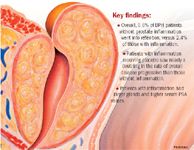Article
BPH patients with inflammation show heightened risk of AUR
Istanbul, Turkey--Prostate inflammation significantly raises the risk of clinical progression in men with lower urinary tract symptoms and BPH, according to a first-time investigation into the impact of acute and/or chronic inflammation on men with BPH. The most significant impact of acute or chronic inflammation was an increased risk of acute urinary retention, particularly in patients receiving placebo, according to the analysis, based on a subset of patients from the Medical Therapy of Prostatic Symptoms (MTOPS) patient cohort.

The data also show that patients with prostate inflammation have larger glands and higher serum PSA values.
"We found no difference between placebo-treated patients or patients treated with single-arm therapy (doxazosin [Cardura] or finasteride [Proscar]) in terms of symptom improvement and endpoint progression if there was no inflammation present. I find that surprising to say the least," said lead author Claus G. Roehrborn, MD, professor and chairman of urology at the University of Texas Southwestern, Dallas.

Patients in the study were over the age of 50 years and had an International Prostate Symptom Score >8 points, serum PSA <10.0 ng/mL, and no restriction on prostate volume. The patients underwent transrectal ultrasound-guided sextant prostate biopsies at baseline, which was standard in the MTOPS trial. The study excluded MTOPS patients who had prostate cancer at baseline or during the study course.
While estimates vary, between 30% and 60% of surgical specimens (from TURP or open prostatectomy) contain infiltrates of acute or chronic inflammation (ACI), and the proportion is similar in prostate biopsies performed for elevated serum PSA, Dr. Roehrborn said.
"Inflammatory infiltrates in patients with LUTS and BPH are apparently of greater significance than previously recognized. Their presence in non-treated patients predicts a worse natural history, with more endpoints being reached," he said.
Inflammation comparison Histologic evaluation of the 1,056 sextant biopsies revealed that 46.5% had ACI. Among those with ACI, nearly half (43.3%) of all biopsies, by far the greatest proportion, had chronic inflammatory infiltrates, while 0.7% had acute inflammation, and 2.6% had acute or chronic inflammation.
Histology detected no ACI in 53.5% of patients. Hyperplasia was seen in 40% of the samples. Total/free PSA values in the non-ACI and chronic inflammation groups were 2.3/0.5, and 3.1/0.6, respectively.
Total prostate and transition zone volumes were significantly different between the non-ACI and the ACI groups: 36.5 versus 40.3, and 16.1 vs. 19.2, respectively, in the non-ACI vs. ACI groups.






